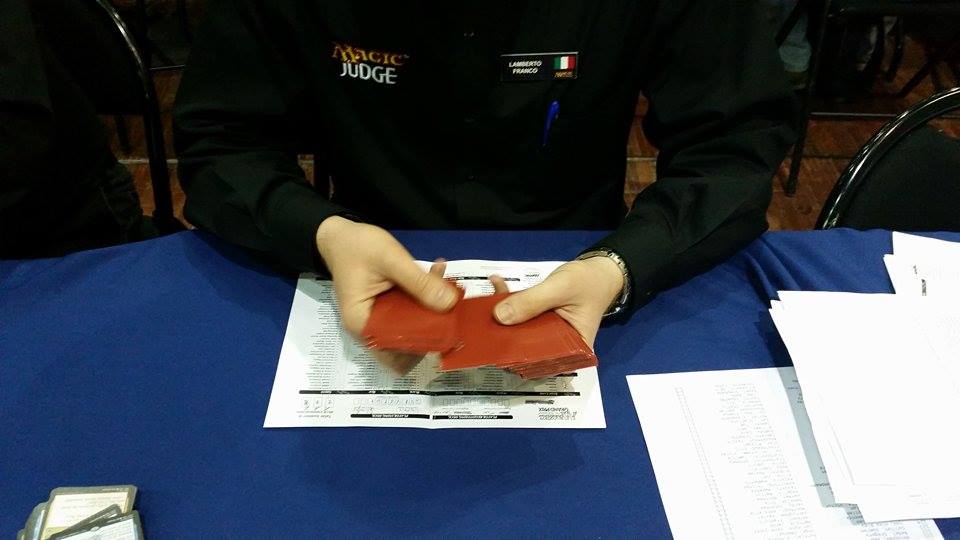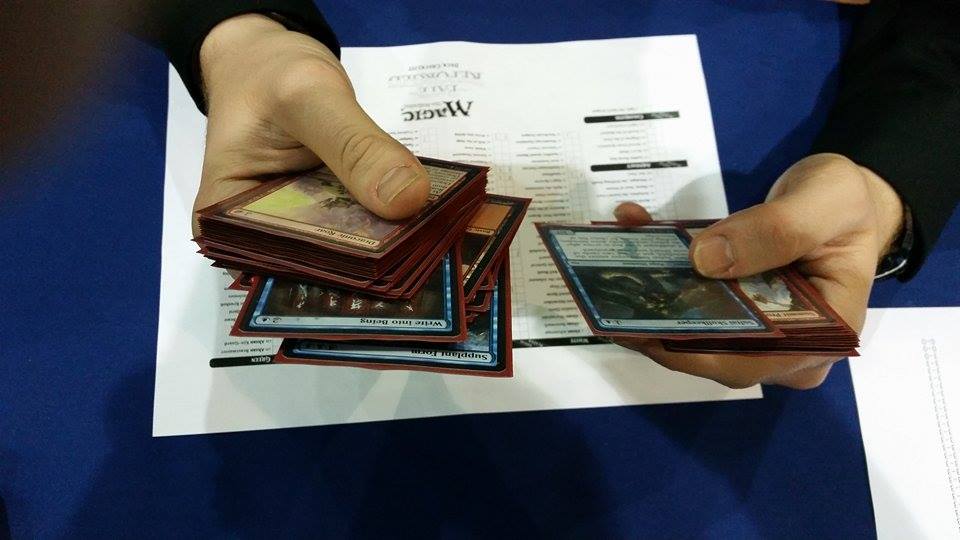As judges we strive to improve ourselves and the way we operate tournaments in order to provide the best service possible to players, organizers and other judges. Sometimes the improvement needs to be personal (i.e. how to communicate a ruling or study of the documents); sometimes it may involve the program itself (i.e. new level definition or policy updates) or our procedures during the event.
The key point of the Australian DC is to save time by not changing the order of the cards in the decks: in this way, you’ll be faster in performing the deck check and players won’t need to shuffle the decks after the check. You may even be able to perform a full deck check and give only a +3 minutes time extension!
Who?
In order to maximize the performance, you’ll need one judge to fetch the decklists (and count 40+ maindeck cards) while you are grabbing the decks, so that decklists may be available as soon as you arrive with the decks.
You’ll need to tell the players that you’re using a new technique for the deck check and that you are returning the decks with cards in the same exact order, so that they won’t need to shuffle everything again and they may immediately start their game.
What?
The Australian DC is simple yet extremely efficient:
- Turn the deck face down and quickly count you have at least 40 cards while checking the sleeves for any marks (Video: https://www.youtube.com/watch?v=9iqifPg2ib0)

- Turn the deck face up, review the deck a first time to count all the basic lands against the decklist while verifying the deck is sufficiently randomized (Video: https://www.youtube.com/watch?v=lNhGuMjAue4)

- Start a second review of the deck face up and check that every spell and nonbasic land is correctly listed in the played column. If you see that there are multiple copies of that spell or nonbasic land, keep the card(s) slightly upward until you find all the copies (Video: https://www.youtube.com/watch?v=vfKv2Uy-2ZE)
That’s it! (Complete video: https://www.youtube.com/watch?v=1BybxAK7CZY)
You may perform additional checks on the sideboard in the usual way if needed. Usually you only need to check for cards already sleeved or cards in the top part of the sideboard, since they are the ones that the player may conceivably side in.
If you find any problem with the deck that requires you to alter the order of the cards (i.e. possible patterns in the sleeves or your dexterity errors while sweeping the deck), please give to players the traditional 3 extra minutes of time extension for properly shuffling.
Where?
When?
You may use the Australian DC in Limited events only, since it’s much more efficient the fewer copies of a single spell you have. The technique performs the best for single-set Limited, so that you don’t have to turn the decklist back and forth for cards of different sets, but may be applied to multi-set Limited by repeating step 3 once per set and it will still be faster than a traditional check.
You may achieve the highest speed during midround deck checks because you don’t need to follow step 2 (players may change any number of basic lands) and in step 3 you need to check only against the total column (no need to check for the played column). All you’ll have to do is to review the deck once face down (step 1) and once face up (step 3) (Midround video: https://www.youtube.com/watch?v=nIRLYTkVhjQ). I’ve witnessed a judge performing this deck check in an astonishing 48 seconds!
Why?
The downside is that players are not used to receiving the deck back from a check and not shuffling it. Tell them clearly that there is no such need because you did not change the order of the cards and invite them to resume play by shuffling their opponent’s deck.
Acknowledgments
I want to thank James MacKay, Nathan Brewer
, and Fabian Peck
for the willingness to experiment and teach new techniques and Lamberto Franco
for providing pictures and video for this article.
Special thanks to the official GP Coverage team for filming and publishing an Australian Deck Check during GP Utrecht 2015 (Video: https://www.youtube.com/watch?v=F-rryi_q7pk)
